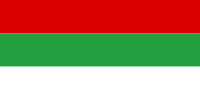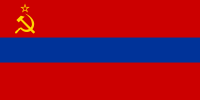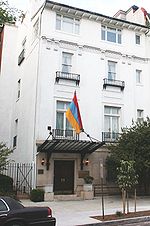- Flag of Armenia
-
Flag of Armenia
Name Armenian:Եռագույն(Yerrak'ouyn) Use National flag 
Proportion 1:2 Adopted 24 August 1990 Design A horizontal tricolour of red, blue, and orange Designed by The independent Armenian government 
Variant flag of Armenia Name Հայաստանի Զինանշան (Hayastani Zeenan'shan) Use National flag 
Proportion 1:2 Adopted 24 August 1990 Design Same concept of the tricolour along with the coat of arms of Armenia placed centrally on top of the flag.[citation needed] The national flag of Armenia, the Armenian Tricolour (known in Armenian as Եռագույն, Yerrak'ouyn), consists of three horizontal bands of equal width, red on the top, blue in the middle, and orange (also described as "colour of apricot") on the bottom. The Armenian Supreme Soviet adopted the current flag on 24 August 1990. On 15 June 2006, the Law on the National Flag of Armenia, governing its usage, was passed by the National Assembly of Armenia.
Throughout history, there have been many variations of the Armenian flag. In ancient times, Armenian dynasties were represented by different symbolic animals displayed on their flags.[1] In the twentieth century, various Soviet flags represented the Armenian nation.
The meanings of the colors have been interpreted in many different ways. For example, red has stood for the blood shed by Armenian soldiers in war, blue for the Armenian sky, and orange represents the fertile lands of Armenia and the workers who work them.[2]
The official definition of the colors, as stated in the Constitution of the Republic of Armenia, is:
“ The Red emblematizes the Armenian Highland, the Armenian people's continued struggle for survival, maintenance of the Christian faith, Armenia's independence and freedom. The Blue emblematizes the will of the people of Armenia to live beneath peaceful skies. The Orange emblematizes the creative talent and hard-working nature of the people of Armenia.[3] ” Contents
Design
Since the Armenian government does not specify the exact shades of red, blue, and orange, two different versions of the flag are in common use. The more common version consists of brighter shades, whereas the colors of the less common version are more muted. The following table gives the approximate RGB values of the colors used in those two versions:[4]
More common version Less common version 

Red 255-0-0 216-28-63 Blue 0-0-170 85-117-196 Orange 255-153-0 239-107-0 History
Today's tricolor flag bears little resemblance to the earliest Armenian 'flags'; in ancient times, armies went into battle behind carvings mounted on poles. The carvings might represent a dragon, an eagle, a lion or "some mysterious object of the gods."[1] With the advent of Christianity, the Armenian empire adopted many different flags representing various dynasties. The Artaxiad Dynasty's flag, for instance, consisted of a red cloth displaying two eagles gazing at each other, separated by a flower.
19th century
After Armenia was split between the Persian and Ottoman Empires, the idea of an Armenian flag ceased to exist for some time. The Armenian Catholic priest Father Ghevont Alishan created a new flag for Armenia in 1885, after the Armenian Students Association of Paris requested one for the funeral of the French writer Victor Hugo. Alishan's first design was very similar to today's Armenian flag: a horizontal tricolor. However, it looks more like an upside-down variation of the current flag of Bulgaria. The top band was red, symbolizing the first Sunday of Easter (called "Red" Sunday), followed by a green band to represent the "Green" Sunday of Easter, and finally an arbitrary color, white, was chosen to complete the combination.[1] While in France, Alishan also designed a second flag, identified today as the "Nationalist Armenian Flag." It too was a tricolor, but unlike the previous design, this one was a vertical tricolor similar to the French flag. Its colors were red, green, and blue, from left to right, representing the rainbow that Noah saw after landing on Mount Ararat.[1]
Transcaucasian Democratic Federative Republic
In 1828, Persian Armenia was annexed to the Russian Empire after the last Russo-Persian War, and became known as Russian Armenia. When the Russian Empire collapsed, Russian Armenia declared its independence and joined the short-lived Transcaucasian Democratic Federative Republic, together with Georgia and Azerbaijan. This unified state hardly lasted a year and was soon dissolved. Since the Republic was short-lived, it did not use any flags or symbols. Nevertheless, some historians consider a horizontal gold, black, and red tricolor, similar to that of the German flag but arranged differently, to have been flag of Transcaucasia.[5] The federation was dissolved on May 26, 1918, when Georgia declared its independence as the Democratic Republic of Georgia. Both Armenia and Azerbaijan declared their independence two days later, on May 28, 1918, as the Democratic Republic of Armenia (DRA) and the Azerbaijan Democratic Republic (ADR), respectively.
Democratic Republic of Armenia
After gaining independence, the Democratic Republic of Armenia adopted the modern Armenian tricolor. Upon Stepan Malkhasyants's appearance in the Armenian National Council,[6] the independent Armenian government selected the colors used during the last period of Rubenid Dynasty, red, blue and yellow. An earlier prototype, which was eventually rejected, was a rainbow flag. This prototype can be seen at the Martiros Saryan House Museum in Yerevan, Armenia. They chose to replace the yellow with orange "because it merged better with the other two colors, presenting a more pleasing composition."[1] The flag of independent Armenia then had a ratio of 2:3, but on August 24, 1990, when the Armenian Supreme Soviet adopted it as the flag of the Republic of Armenia, the ratio was changed to 1:2.[7]
Early Soviet Armenia and the Transcaucasian SFSR
Main article: Flag of the Transcaucasian SFSROn November 29, 1920 Bolsheviks established the Armenian SSR. A new flag was introduced and fixed in the constitution, accepted on February 2, 1922 by the First Congress of Soviets of the Armenian SSR.[8] That flag existed only for a month, because on March 12 the Armenian SSR united with the Georgian SSR and the Azerbaijan SSR under the Transcaucasian SFSR (TSFSR). On December 30, 1922 the Transcaucasian SFSR became one of the four Soviet republics that united to form the USSR. The flag of the republic had a hammer and sickle inserted into a star with initials "ЗСФСР" (ZSFSR) written in Russian sans-serif script. These letters stand for Закавказская Советская Федеративная Социалистическая Республика (Zakavkazskaya Sovetskaya Federativnaya Socialisticheskaya Respublika, "Transcaucasian Soviet Federative Socialist Republic").[8] In 1936, the TSFSR was broken up into its three constituent regions, which were named the Georgian SSR, the Armenian SSR, and the Azerbaijan SSR.
Armenian SSR
Main article: Flag of the Armenian SSRAs a republic of the USSR, the Armenian SSR introduced its first flag in 1936. Very similar to the flag of the Soviet Union, it was red and featured a yellow hammer and sickle in the corner. Underneath that, there were "H-Kh-S-H" initials written in Armenian serif script. These initials, in the Western Armenian language, stand for "Haygagan Khorhurtayin Sodzialistakan Hanrabedutyun," or the "Armenian Soviet Socialist Republic." In the 1940s, the flag was altered to use the Eastern Armenian language spoken in the Republic. The initials were changed to "H-S-S-R" meaning "Hayastani Sovetakan Sotsialistikakan Respublika" in the Eastern Armenian pronunciation. In 1952, a new flag was introduced. The initials were removed completely and in their place a horizontal blue stripe was added.
In late May 1988, amid rising nationalist tensions, Armenia's new Communist party leader allowed the banned tricolour of the DRA to fly in Yerevan for the first time in over sixty years.[9] A year later, following a Nagorno-Karabakh-themed mass demonstration where the tricolour was flown, he urged its official recognition.[10] This came on August 24, 1990, a day after the Armenian Supreme Soviet declared the republic's sovereignty and renamed the country the Republic of Armenia. At that point, just over a year before Armenia declared its formal independence from the USSR, the tricolour replaced the 1952 flag.
Usage
The 2006 law on the National Flag of Armenia states that the flag has to be raised on the following public buildings:
- Residence of the President
- Parliament
- Government
- Constitutional court
- Office of Public Prosecutor
- Central Bank of Armenia
- other governmental buildings
The Law requires to lower the flag to the midpoint of the flagpole on the days of mourning or during mourning ceremonies. A black ribbon needs to be placed at the top of the flag; the length of the ribbon should be equal to the length of the flag. The flying flag has to be raised in its entirety, clean, and unfaded; moreover, the lower part of the flag should be at least 2.5 m off the ground.[11]
National flag days
The day of the National Flag of Armenia is being marked on 15 June of every year. The day was chosen for the reason that the Armenian law on the National Flag of Armenia was passed on 15 June 2006.[12] The day of the Armenian tricolour was celebrated for the first time on 15 June 2010 in Yerevan.[13]
The daily display of the Armenian flag is encouraged, but legally required only on the following days:[14][15]
- January 1, January 2 – New Year
- January 6 – Christmas
- March 8 – International Women's Day
- April 7 – Motherhood and Beauty Day
- May 1 – International Worker's Solidarity Day
- May 9 – Victory and Peace Day
- May 28 – First Armenian Republic Day, 1918
- July 5 – Constitution Day, 1995
- September 21 – Independence Day, 1991
- December 7 – Spitak Earthquake Memorial Day, 1988
Influence
On June 2, 1992, the self-proclaimed Republic of Nagorno-Karabakh adopted a flag similar to the Armenian tricolor. A white, five-toothed, stepped carpet pattern was added to the flag, beginning at the two verges of the cloth’s right side and connecting at a point equal to one-third of the distance from that side.[16] The white pattern symbolizes the current separation of Artsakh (Nagorno-Karabakh) from Armenia proper and its aspiration for eventual union with "the Motherland."[17] The ratio of the flag’s breadth to its length is 1:2, same as the Armenian Tricolor.[16]
In addition to the flag of Nagorno-Karabakh, the Armenian flag colors influenced the design of the Pan-Armenian Games flag. In the center of the light blue flag are six interlocking rings, derived from the Olympic rings. The sixth, orange-colored ring, interlocks with the blue and red rings, which symbolize Armenia. Above the rings is a flame in the colors of the Armenian flag.[18]
The national flag is also mentioned in the song "Mer Hayrenik", the national anthem of Armenia. Specifically, the second and third stanzas sing about the creation of the national flag:
Here brother, for you a flag,
That I made with my hands
Nights I didn't sleep,
With tears I washed it.
(repeat previous two lines)
Look at it, three colors
It's our gifted symbol.
Let it be bright against the enemy.
Let Armenia always be glorious.
(repeat previous two lines)[19]See also
References
- ^ a b c d e "The Evolution of the Armenian Flag". Armenianheritage.com. http://www.armenianheritage.com/hiflag.htm. Retrieved 2007-01-05.
- ^ "Armenia". Vexilla Mundi. http://www.vexilla-mundi.com/armenia_flag.html. Retrieved 2007-01-06.
- ^ "General Information: section the Flag". Government of Republic of Armenia. http://www.gov.am/en/official/. Retrieved 2010-10-21.
- ^ The Jasc Paint Shop Pro v. 8 program was used to collect the RGB values for the listed flags.
- ^ "Закавказская Федерация (Transcaucasian Democratic Federative Republic)" (in Russian). Russian Centre of Vexillology and Heraldry. 2003-05-30. http://hrono.rspu.ryazan.ru/heraldicum/flagi/gruzia/federat.htm. Retrieved 2006-12-27.
- ^ "Республика Армения (Democratic Republic of Armenia)" (in Russian). Russian Centre of Vexillology and Heraldry. 2003-03-28. http://hrono.rspu.ryazan.ru/heraldicum/flagi/armenia/ar.htm. Retrieved 2006-01-09.
- ^ "Armenia: First Republic (1918–1921)". Flags of the World. http://www.fotw.net/flags/am_.html#1918. Retrieved 2007-01-09.
- ^ a b "Cоветская Армения (Soviet Armenia)" (in Russian). Russian Centre of Vexillology and Heraldry. 2004-11-14. http://www.hrono.ru/heraldicum/flagi/armenia/assr.htm. Retrieved 2007-01-20.
- ^ De Waal, Thomas. Black Garden: Armenia and Azerbaijan Through Peace and War, pp. 60-1. NYU Press, 2003, ISBN 0-8147-1945-7.
- ^ King, Sarah Sanderson and Cushman, Donald P. Political Communication: Engineering Visions of Order in the Socialist World, p. 102. SUNY Press, 1992, ISBN 0-7914-1201-6.
- ^ "The Law of the Republic of Armenia about the national flag" (in Armenian). Armenian Legal Information System. http://www.laws.am/DocumentView.aspx?docID=21339. Retrieved 2008-03-28.
- ^ "Demotix news: State Flag Day celebrations in Armenia". http://www.demotix.com/news/358528/state-flag-day-celebrations-armenia. Retrieved 2010-06-15.
- ^ "Yerevan Report: Armenian Flag Day Marked on June 15". http://www.yerevanreport.com/2010/06/17/armenian-flag-day-june-15/. Retrieved 2010-06-16.
- ^ "Flag Days Of The World". Flags of the World. http://www.crwflags.com/fotw/flags/fdw.html. Retrieved 2006-12-29.
- ^ "About Armenia". Permanent Mission of Armenia to the United Nations. http://un.cti.depaul.edu/public/Armenia/1/English/. Retrieved 2006-12-29.
- ^ a b "Attributes of Statehood". Ministry of Foreign Affairs of Nagorno-Karabakh. Archived from the original on December 16, 2006. http://web.archive.org/web/20061216152933/http://www.nkr.am/eng/gov/atributy.html. Retrieved 2007-01-09.
- ^ "Flag of Artsakh / Nagorno-Karabakh". Flags of the World. http://www.crwflags.com/fotw/flags/az-artsa.html. Retrieved 2007-01-09.
- ^ "Armenia: Sport flags". Flags of the World. http://www.crwflags.com/fotw/flags/am@.html. Retrieved 2007-01-09.
- ^ "Lyrics of Mer Hayrenik". National Anthems.net. http://www.nationalanthems.info/am.htm. Retrieved 2007-01-10.
External links
- Armenia at Flags of the World
- The Evolution of the Armenian Flag
- (Russian) Flags of Armenia
- Armenica.org - Symbolic values and information about the Armenian flag and coat of arms
 Armenia topics
Armenia topicsHistory (timeline) EarlyOrigins · Name · Kura-Araxes culture · Hayk · Hayasa-Azzi · Mitanni · Nairi · Kingdom of Urartu · Orontid dynasty · Kingdom of Armenia · Roman Armenia · Byzantine Armenia · Bagratuni Armenia · Armenian Kingdom of CiliciaMiddleModernBy topicGovernment and
politicsConstitution · President · Prime Minister · National Assembly · Political parties · Elections · Foreign relations · Corruption · Human rights · LGBT rights · Relations with the European Union · more on government / politicsEconomy Armenian dram · Central Bank · List of companies · Armex · Agriculture · Industry · Communications · Transport · Energy · Mining · Waste management · International rankingsAdministrative
divisionsArmed Forces Geography Demographics Religion Culture Symbols Flags of Europe Sovereign
states- Albania
- Andorra
- Armenia
- Austria
- Azerbaijan
- Belarus
- Belgium
- Bosnia and Herzegovina
- Bulgaria
- Croatia
- Cyprus
- Czech Republic
- Denmark
- Estonia
- Finland
- France
- Georgia
- Germany
- Greece
- Hungary
- Iceland
- Ireland
- Italy
- Kazakhstan
- Latvia
- Liechtenstein
- Lithuania
- Luxembourg
- Macedonia
- Malta
- Moldova
- Monaco
- Montenegro
- Netherlands
- Norway
- Poland
- Portugal
- Romania
- Russia
- San Marino
- Serbia
- Slovakia
- Slovenia
- Spain
- Sweden
- Switzerland
- Turkey
- Ukraine
- United Kingdom
- (England
- Northern Ireland
- Scotland
- Wales)
- Vatican City
States with limited
recognition- Abkhazia
- Kosovo
- Nagorno-Karabakh
- Northern Cyprus
- South Ossetia
- Transnistria
Dependencies
and other territories- Åland
- Faroe Islands
- Gibraltar
- Guernsey
- Jan Mayen
- Jersey
- Isle of Man
- Svalbard
Other entities - European Union
National flags and coats of arms National flags National coats of arms Categories:- National flags
- National symbols of Armenia
Wikimedia Foundation. 2010.









